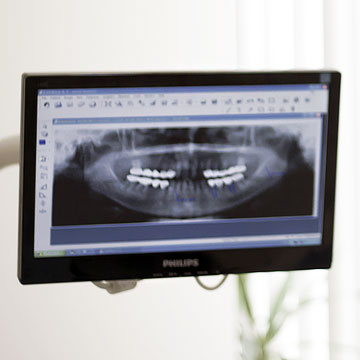
Why do I need dental x-rays?
We are often asked, “Why do I need dental x-rays?” Alabaster general and family dentist Dr. Joseph Zanthos will generally recommend periodic dental x-rays to check the health of the teeth, gums and jaw bone.
During your dental check-up visit, Dr. Zanthos will visually examine your teeth and oral soft tissue with dental instruments. In order to provide you with a complete oral health assessment, he relies on dental x-rays to ‘see’ areas beneath the gums such as tooth roots and jaw bone structures.
How do dental x-rays work?
Dental x-rays are also an invaluable tool to assist Dr. Zanthos' in checking hidden contact areas between the teeth; these are the most common locations where tooth decay develops.

X-rays are designed to detect density. In a dental x-ray, hard structures like teeth, dental fillings and bone appear white, or radiopaque. Less dense areas, such as gums, soft tissue, nerves, ligaments and blood vessels appear darker or grayish. Areas with very low density look nearly black on an x-ray. In dentistry, these varying density levels, or ‘shades of gray’ have special meaning.
Dr. Zanthos uses digital dental x-rays that require minimal radiation exposure to look for ‘shadows’ that appear in the wrong places, including:
Tiny, dark, crescent-shaped areas between teeth or on the chewing surfaces that indicate possible tooth decay.
Reduced density in jawbone levels surrounding teeth; this may be a sign of periodontal (gum) disease that can lead to tooth loss.
Dark circles at the tip of tooth roots or in the jawbone that may be an indication of a tooth abscess or infection.
There are many different types of dental x-rays, among the most common include:
Periapical dental x-rays - these are used to take a close up view of 1-3 teeth. These images include the entire tooth root and are especially important for diagnosing root abscesses or bone loss around teeth.
Panoramic x-rays - A panoramic dental x-ray is an image that is taken of the entire jaw and all of the teeth. It is used to look for jaw defects or tumors. It is also used for evaluating un-erupted or partially erupted teeth and is an important aid in children's dentistry.
Bitewing, or cavity detection x-rays - These images are taken with the teeth biting together. They are useful for checking for tooth decay between the teeth and to look for signs of bone loss.
Cone Beam Computed Tomography (CBCT) - Dr. Zanthos and our dental specialists (oral surgeons, periodontists and endodontists) use CBCT imaging to evaluate the jawbone from multiple angles. This is valuable in planning dental implants or other dental surgical procedures.
Dr. Zanthos will review your most recent x-rays at your regular dental examination and cleaning visits and recommend any updates as needed. Digital dental x-rays allow him to display x-rays of your teeth on a computer screen as he shares his findings with you.
Do you have questions about dental x-rays or dental treatment?
Contact our Premier Family Dentistry of Alabaster Team to schedule your next dental check-up and let us help you keep your smile healthy.